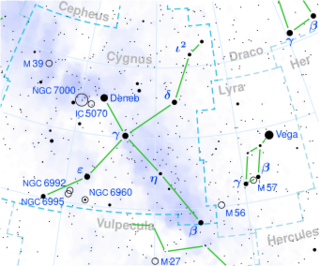Astronomy:55 Cygni
| Observation data Equinox J2000.0]] (ICRS) | |
|---|---|
| Constellation | Cygnus |
| Right ascension | 20h 48m 56.29119s[1] |
| Declination | +46° 06′ 50.8824″[1] |
| Apparent magnitude (V) | 4.86[2] (4.81 - 4.87[3]) |
| Characteristics | |
| Spectral type | B2.5Ia[4] - B4Ia[5] |
| U−B color index | −0.45[2] |
| B−V color index | +0.42[2] |
| Variable type | L[3] or α Cyg[6] |
| Astrometry | |
| Radial velocity (Rv) | −7.2[7] km/s |
| Proper motion (μ) | RA: −2.65[1] mas/yr Dec.: −2.84[1] mas/yr |
| Parallax (π) | 1.40 ± 0.17[1] mas |
| Distance | 830[8] pc |
| Absolute magnitude (MV) | −6.93[8] - −7.26[9] |
| Details[6] | |
| Mass | 23[9] M☉ |
| Radius | 54 - 65 R☉ |
| Luminosity | 324,000 - 478,000 L☉ |
| Surface gravity (log g) | 2.35 - 2.50 cgs |
| Temperature | 18,600 - 19,000 K |
| Rotational velocity (v sin i) | 61[9] km/s |
| Other designations | |
| Database references | |
| SIMBAD | data |
55 Cygni (55 Cyg) is a blue supergiant star in the constellation Cygnus. It is thought to be a member of the Cygnus OB7 stellar association at about 2,700 light years.
Its apparent magnitude is 4.86, but this is slightly variable and the star is also called V1661 Cyg. When first analysed, it was classified as an irregular supergiant variable,[11] but subsequent studies have treated it as an Alpha Cygni variable. It shows pulsations with multiple periods from a few hours to 22 days, and both p- and g-modes.[6] Apart from p- and g-modes, strange mode and associated instabilities have also been found in models of this star.[12] The spectrum also shows variation, leading to different classifications being given for the star.[13]
The exact properties of 55 Cygni are not known precisely and are also variable. It is a hot luminous supergiant several hundred thousand times as luminous as the sun. This star was originally a standard for the B3 Ia spectral type.[14]
The type of pulsations that 55 Cyg exhibits suggest that it was previously a red supergiant that has shed its outer layers. The most massive red supergiants are expected to pass through a blue supergiant phase before becoming a Wolf-Rayet star and eventually exploding as a type Ib or Ic supernova.[6]
References
- ↑ 1.0 1.1 1.2 1.3 1.4 Van Leeuwen, F. (2007). "Validation of the new Hipparcos reduction". Astronomy and Astrophysics 474 (2): 653–664. doi:10.1051/0004-6361:20078357. Bibcode: 2007A&A...474..653V.
- ↑ 2.0 2.1 2.2 Ducati, J. R. (2002). "VizieR Online Data Catalog: Catalogue of Stellar Photometry in Johnson's 11-color system". CDS/ADC Collection of Electronic Catalogues 2237. Bibcode: 2002yCat.2237....0D.
- ↑ 3.0 3.1 Samus, N. N. et al. (2009). "VizieR Online Data Catalog: General Catalogue of Variable Stars (Samus+ 2007-2013)". VizieR On-line Data Catalog: B/GCVS. Originally Published in: 2009yCat....102025S 1. Bibcode: 2009yCat....102025S.
- ↑ Prinja, R. K.; Massa, D. L. (2010). "Signature of wide-spread clumping in B supergiant winds". Astronomy and Astrophysics 521: L55. doi:10.1051/0004-6361/201015252. Bibcode: 2010A&A...521L..55P.
- ↑ Zorec, J.; Cidale, L.; Arias, M. L.; Frémat, Y.; Muratore, M. F.; Torres, A. F.; Martayan, C. (2009). "Fundamental parameters of B supergiants from the BCD system. I. Calibration of the (λ_1, D) parameters into Teff". Astronomy and Astrophysics 501 (1): 297–320. doi:10.1051/0004-6361/200811147. Bibcode: 2009A&A...501..297Z.
- ↑ 6.0 6.1 6.2 6.3 Kraus, M.; Haucke, M.; Cidale, L. S.; Venero, R. O. J.; Nickeler, D. H.; Németh, P.; Niemczura, E.; Tomić, S. et al. (2015). "Interplay between pulsations and mass loss in the blue supergiant 55 Cygnus = HD 198 478". Astronomy & Astrophysics 581: A75. doi:10.1051/0004-6361/201425383. Bibcode: 2015A&A...581A..75K.
- ↑ Wilson, Ralph Elmer (1953). "General catalogue of stellar radial velocities". Washington. Bibcode: 1953GCRV..C......0W.
- ↑ 8.0 8.1 Markova, N.; Puls, J. (2008). "Bright OB stars in the Galaxy. IV. Stellar and wind parameters of early to late B supergiants". Astronomy and Astrophysics 478 (3): 823. doi:10.1051/0004-6361:20077919. Bibcode: 2008A&A...478..823M.
- ↑ 9.0 9.1 9.2 Searle, S. C.; Prinja, R. K.; Massa, D.; Ryans, R. (2008). "Quantitative studies of the optical and UV spectra of Galactic early B supergiants. I. Fundamental parameters". Astronomy and Astrophysics 481 (3): 777. doi:10.1051/0004-6361:20077125. Bibcode: 2008A&A...481..777S.
- ↑ "/ftp/cats/more/HIP/cdroms/cats". Strasbourg astronomical Data Center. https://cdsarc.cds.unistra.fr/viz-bin/ftp-index?/ftp/cats/more/HIP/cdroms/cats.
- ↑ Lefèvre, L.; Marchenko, S. V.; Moffat, A. F. J.; Acker, A. (2009). "A systematic study of variability among OB-stars based on HIPPARCOS photometry". Astronomy and Astrophysics 507 (2): 1141. doi:10.1051/0004-6361/200912304. Bibcode: 2009A&A...507.1141L.
- ↑ Yadav, Abhay Pratap; Glatzel, Wolfgang (2016). "Stability analysis, non-linear pulsations and mass loss of models for 55 Cygni (HD 198478)" (in en). Monthly Notices of the Royal Astronomical Society 457 (4): 4330–4339. doi:10.1093/mnras/stw236. ISSN 0035-8711. Bibcode: 2016MNRAS.457.4330Y.
- ↑ Maharramov, Y. M. (2013). "Spectral variability of the STAR 55 Cyg B3 Ia". Astronomy Reports 57 (4): 303–309. doi:10.1134/S1063772913030037. Bibcode: 2013ARep...57..303M.
- ↑ Morgan, W. W.; Roman, Nancy G. (1950). "Revised Standards for Supergiants on the System of the Yerkes Spectral Atlas". Astrophysical Journal 112: 362. doi:10.1086/145351. Bibcode: 1950ApJ...112..362M.
 |



